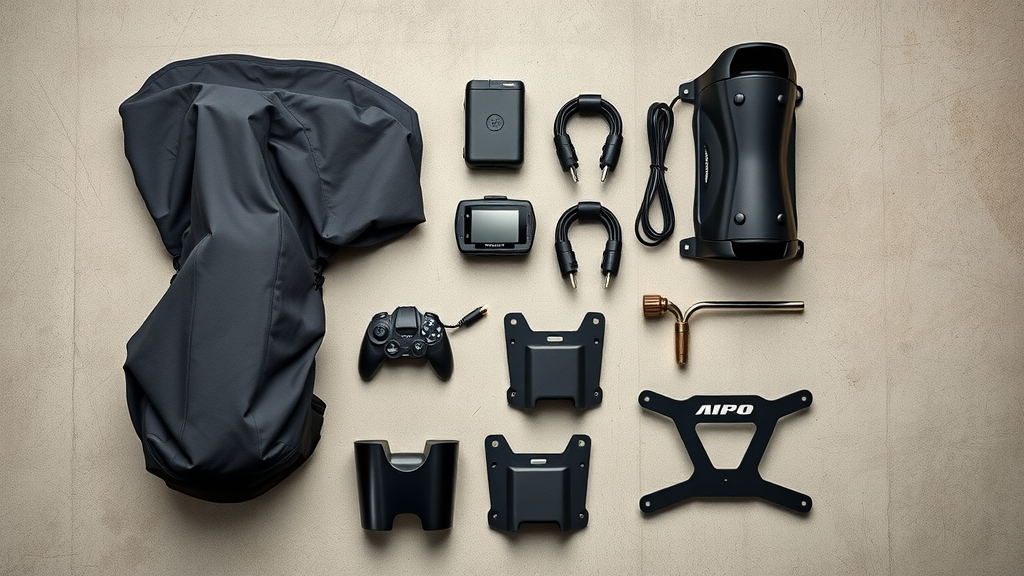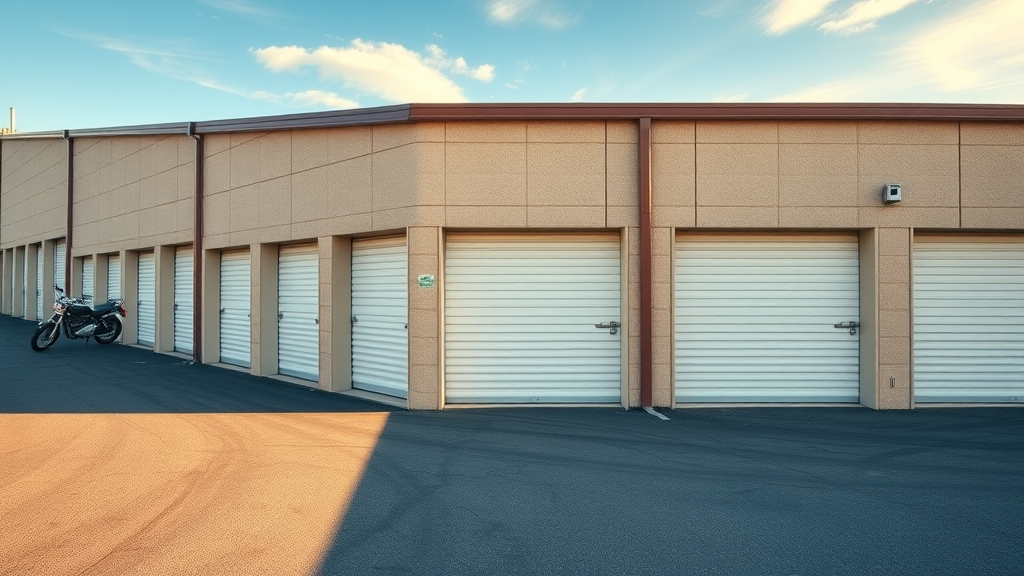Did you know that every year, 40% of motorcycle owners experience avoidable damage due to poor storage habits? This statistic isn’t just a number—it’s a wake-up call for riders everywhere. Whether you're weathering the harsh winter months or stowing away your bike during summer, improper seasonal motorcycle storage can lead to battery failure, rust, and expensive repairs. Let’s dive into actionable tips to safeguard your investment so you can hit the road, worry-free, whenever the season returns.
Every Year, 40% of Motorcycle Owners Experience Avoidable Damage—Why Seasonal Motorcycle Storage Matters
-
Discover the surprising risks of improper motorcycle storage, from battery failure to rust, and how seasonal motorcycle storage can safeguard your investment.
Seasonal motorcycle storage is more than just a good idea—it’s an essential practice to protect your bike from deterioration. Without a proper routine, motorcycles are highly susceptible to corrosion, battery drain, and fuel system issues. Each winter storage period brings risks: fluctuating temperatures cause condensation inside fuel tanks; dead leaves and debris can trap moisture and accelerate rust. Failing to use a quality motorcycle cover, stabilizing your fuel, or selecting the right storage unit can turn a flawless machine into a springtime repair bill. Every aspect of motorcycle winter storage —from insurance to tire care—fights against the silent damage that creeps in when you’re not riding.
Overlooking seasonal storage solutions often leads to dead batteries, stale fuel, and pitted chrome. Remember: protecting your ride now is the key to an exhilarating, hassle-free first ride when you bring your motorcycle out of hibernation. Let’s look at practical steps you can take to store your bike safely—starting with understanding why a dedicated seasonal storage routine is an important part of motorcycle ownership.

Safeguarding Your Ride: The Importance of Seasonal Motorcycle Storage
-
Explaining the critical benefits of implementing a seasonal motorcycle storage routine.
-
Highlight common scenarios: winter motorcycle storage, summer layups, and more.
Implementing a reliable seasonal motorcycle storage process is crucial, whether you’re prepping for winter motorcycle storage in cold climates or planning a summer layup before a long vacation. This proactive approach significantly reduces wear and tear on your engine, tires, and electrical system, extending your bike’s longevity. For those in harsh climates, winter storage is indispensable—humidity, road salts, and freezing temperatures can ruin a motorcycle left exposed or neglected.
Summer also brings its own unique storage challenges. Extended trips or travel plans may mean your bike sits unused in high temperatures that can evaporate fuel or weaken your battery. No matter the season, the right motorcycle storage solution —be it your home garage, a professional storage facility, or a rental storage unit—will protect your ride from elements and unwanted attention. By making seasonal storage a regular habit, you ensure your motorcycle stays in full operating condition, ready to hit the road as soon as the weather turns.
In every scenario, the goal is the same: keep your bike protected from the environment and theft, minimize maintenance costs, and maximize its resale value. With the right preparation and storage option, you’re investing not only in the performance of your motorcycle but also in your own peace of mind.
What You'll Gain by Mastering Seasonal Motorcycle Storage
-
Understand reduced wear and tear, extend your bike's lifespan, and save on costly repairs with proper seasonal motorcycle storage.
By mastering seasonal motorcycle storage , riders benefit from a host of long-term rewards. First, you dramatically reduce the risk of unexpected repairs associated with improperly stored bikes. Exposure to condensation and fluctuating temperatures during the winter months often leads to rusty frames, dead batteries, and fuel system problems. Implementing a proper winter motorcycle storage plan means your bike remains at its best, saving you from avoidable expenses when you decide to ride again.
Additionally, the correct storage unit option minimizes depreciation. Routine maintenance, like prepping your motor oil or keeping your tires at optimal pressure, directly prolongs the life of key components. Bikes stored using the right motorcycle cover and environmental controls are less susceptible to corrosion and retain higher resale value. With these tangible benefits, it’s clear that the time spent preparing your bike for storage pays off through extended lifespan and reliability.
Most importantly, proper preparation means your bike is always ready for action. Instead of dealing with belated fixes, you'll give your bike a smooth transition from storage back to full operating temperature with minimal delay, ensuring every ride starts with confidence.
Essential Steps for Seasonal Motorcycle Storage: Protect Your Bike All Year
-
Thorough cleaning and inspection before storage
-
Draining or stabilizing fuel
-
Battery maintenance
-
Tire care and correct pressure
-
Using proper motorcycle cover and storage option
-
Securing insurance for storage units or locations
The first step to effective seasonal motorcycle storage is a detailed cleaning. Remove grime, bugs, and road salt to prevent accelerated corrosion, focusing on hard-to-reach areas that are most susceptible. As you clean, inspect your bike carefully for any signs of wear, leaks, or damage that need attention before the storage period. Next, address the fuel system by either draining the tank or, if you expect a short layup, adding a quality fuel stabilizer to prevent varnish and gumming.
For battery care, disconnect the battery and use a trickle charger or battery tender to maintain optimal charge during the storage period. This simple measure prevents the number one cause of springtime breakdowns. Check tire pressure and inflate to manufacturer specs to avoid flat spots. Elevate your bike on paddock stands if possible, further reducing the risk of tire deformation.
Finally, ensure your ride is protected against dust and moisture with a heavy-duty, breathable motorcycle cover. If you’re using a storage unit, secure adequate motorcycle insurance to protect against theft or environmental damage. Document your condition and maintenance records for a smooth re-entry when the season returns.

Choosing the Best Motorcycle Storage Option: Units, Solutions, and Home Alternatives
How to Select the Right Storage Unit for Your Motorcycle
-
Factoring in unit size, climate control, and security to ensure optimum motorcycle winter storage.
Selecting the right storage unit for your motorcycle is vital for long-term protection. First, assess unit size—your space must be large enough to accommodate the bike and provide room for access and inspection. Consider a unit measuring at least 5x10 feet for most motorcycles, though larger bikes or additional accessories may require more. Another important feature is climate control. Heated units reduce moisture and condensation, essential in winter months to prevent rust and decay.
Security amenities are equally critical. Opt for storage units with gated access, on-site surveillance, and advanced locks. The safety of your motorcycle in a storage facility goes beyond physical damage—it discourages theft, keeping your investment secure until you’re ready to ride again. Don’t forget to weigh the storage option’s accessibility and distance from your home, as frequent check-ins can be a good idea for those storing valuable or vintage bikes.
Finally, confirm that your insurance policy covers the type of storage unit you choose. Many insurers have specific requirements for security and may offer policy discounts for using premium facilities.
Comparing Motorcycle Storage Solution Types
|
Storage Solution |
Cost (Monthly) |
Security |
Convenience |
|---|---|---|---|
|
Home Garage |
Low (utilities only) |
Variable (depends on home security) |
High (on-site access) |
|
Professional Storage Unit |
Moderate-High ($50–$150) |
High (gated, cameras, alarms) |
Medium (off-site) |
|
Shared/Community Garage |
Variable ($20–$80) |
Medium (shared environment) |
Medium-High |
Choosing between a home garage, professional storage facilities, and community options involves balancing cost, convenience, and available security. Home garages offer easy access but may lack advanced climate or theft safeguards. A dedicated motorcycle storage unit is the gold standard for winter storage , boasting both environmental controls and secure access—but generally comes at a higher price. Shared solutions offer savings, making them a smart storage option for those in warmer climates or urban areas.
Always evaluate your neighborhood’s safety and your bike’s specific risk factors before deciding where to store a motorcycle. Picking the best storage option means reviewing every aspect—from unit size to climate features—to ensure you’re covered.
Advantages of Professional Winter Motorcycle Storage Services
-
Highlight why paid storage units are worth considering for winter storage and seasonal motorcycle storage needs.
Professional winter motorcycle storage services offer notable advantages over at-home alternatives. First, they deliver consistent climate control, protecting your motorcycle from moisture, freezing, and extreme temperature swings—factors that accelerate rust and damage. Many units also offer battery maintenance, tire rotation, and periodic engine starts, which help keep your bike’s engine and fluids in top condition all winter long.
Security is another key benefit. Facilities typically feature video surveillance, electronic gate access, and robust locks, reducing the risk of theft. Plus, your motorcycle insurance provider may offer better rates or coverage if you select a professional facility. While more costly than home storage, these units are a wise investment for high-value bikes, vintage models, or anyone seeking true peace of mind during the off-season.
Must-Have Motorcycle Storage Accessories and Tools
-
Detail the essential gear for seasonal motorcycle storage: heavy-duty motorcycle cover, fuel stabilizer, battery charger, paddock stands, desiccants.
Outfitting your bike with the proper motorcycle storage accessories makes all the difference. Start with a heavy-duty, breathable motorcycle cover , which guards against dust, moisture, and accidental scratches. Always use a top-rated fuel stabilizer in your tank if not draining fuel; this keeps the fuel system clean and prevents engine clogs. A quality battery charger or trickle charger is a must, as modern batteries frequently lose charge after only a few weeks of non-use.
Equip your garage or storage unit with paddock stands or center stands to get your bike off its tires, minimizing the risk of developing flat spots. For added moisture protection, use desiccant packs or special storage bags designed to absorb excess humidity—a necessity for areas facing wet winter months or severe condensation.
Finally, consider anti-corrosion sprays or wax coatings as part of your routine, especially on exposed metal and chrome. These must-have tools and accessories don’t just save your bike’s appearance—they actively extend the bike’s operational health and value.

Winter Motorcycle Storage Checklist: Don’t Miss These Steps
-
Actionable list of tasks before long-term winter storage, focusing on avoiding the most common motorcycle winter storage errors.
-
Wash and thoroughly dry your motorcycle to remove road salts and dirt.
-
Inspect for leaks, worn hoses, or corrosion on wires and terminals.
-
Change motor oil and filter to prevent old oil from damaging the engine.
-
Add fuel stabilizer to the tank, or drain fuel for storage periods exceeding 6 months.
-
Inflate tires to the recommended pressure and use paddock stands if possible.
-
Disconnect or remove the battery and place it on a smart charger.
-
Cover your bike with a breathable, weather-resistant motorcycle cover.
-
Confirm your motorcycle insurance policy is active and documents are up to date.
-
Take dated photographs and record mileage for your records.
"Taking time to prepare your bike for seasonal motorcycle storage is the difference between a trouble-free spring ride and costly repairs." — Motorcycle Mechanic Expert
Insurance and Documentation for Seasonal Motorcycle Storage
Do You Need Motorcycle Insurance When Using Storage Units?
-
Understand state requirements and best practices.
Maintaining motorcycle insurance is necessary even when your bike isn’t on the road. Many states require minimum liability coverage for registered vehicles, regardless of their activity. Storage facilities typically require proof of insurance for stored vehicles as an added precaution against theft, fire, or natural disasters.
The smartest practice is to contact your insurer before storing your bike. Ask about storage-specific policies that offer reduced premiums during inactive periods or consider comprehensive-only coverage if allowable in your state. Remember, covering your bike in storage is a good idea that protects your financial investment all year.
Updating Paperwork for Off-Season Storage
-
Tips for documenting your motorcycle's condition, maintenance records, and insurance notifications.
Proper documentation streamlines both winter storage and your eventual return to riding. Log all completed maintenance, including oil changes, tire inflation, and fuel stabilizer treatments. Take detailed photos of your motorcycle from every angle to document its pre-storage condition—this can avert disputes with storage units and help with insurance claims.
Notify your insurance provider whenever your motorcycle’s storage location changes or if you place it in a professional storage facility. Retain copies of your insurance policy, registration, and any maintenance receipts in a safe place. Updated records make it easy to resume full operating status when you’re ready to ride again.
People Also Ask: How much does it cost to store a motorcycle per month?
-
Breaking down typical storage unit fees by location, unit size, and amenities for seasonal motorcycle storage.
The cost to store a motorcycle each month varies widely depending on your chosen storage option. Home garages usually only incur the cost of utilities. Professional storage units range from $50 to $150 per month based on unit size and added features like climate control or enhanced security. Urban locations typically command higher prices. Shared community garages can offer budget-friendly alternatives—with rents from $20 to $80 monthly—though they may lack advanced environmental controls or 24/7 access.
When considering storage units for the winter motorcycle storage period, factor in long-term discounts, extra insurance costs, and the value of amenities like camera surveillance, keypad entry, and temperature regulation. Investing in a reputable storage unit with robust climate and security is often the best value for protecting your ride during the most damaging months.

People Also Ask: Where can I store my motorcycle for the winter?
-
Overview of winter motorcycle storage locations: home garages, commercial storage units, dealership options, and community garages.
There are several winter motorcycle storage options to consider. Your home garage is often the most convenient, offering immediate access and complete control over the storage environment. For those lacking secure space at home, commercial storage units are an excellent choice, providing premium climate control and security. Some powersports dealerships offer winter storage programs that include maintenance as part of the package—ideal for those wanting turnkey solutions.
Community or shared garages present a budget-conscious alternative, while motorcycle-friendly storage facilities may downtown your bike for the off-season and offer access as needed. Whichever storage option you choose, prioritize environmental protection, security, and your ability to regularly check on your bike.
People Also Ask: What is the 12 Second Rule on a Motorcycle?
-
Quick explanation of the 12-second rule and its relevance for safe motorcycle riding and storage-related maneuvers.
The 12-second rule is a riding guideline urging you to scan the road ahead far enough to see what will happen in the next 12 seconds of travel. While primarily a safety concept for riding, it also applies when maneuvering your motorcycle before storage—especially in tight indoor spaces or shared community garages. Taking time to look well ahead helps avoid sudden obstacles and prevents accidental bumps or spills when putting your bike into—or bringing it out of—storage.
People Also Ask: Can I store my motorcycle at public storage?
-
Discuss rules, pros, and cons of using public storage units for your seasonal motorcycle storage needs.
Yes, you can store a motorcycle at many public storage facilities. Rules vary by provider; some require proof of ownership and registration, while others may restrict fuel quantity or demand specific environmental controls. Pros include strong security, climate control options, and reduced risk from home-based hazards. Cons may involve less immediate access, size limitations depending on the unit size , and additional insurance requirements imposed by the storage facility.
Review your chosen facility’s contract and guidelines carefully before signing. Remember to prepare your motorcycle, document all steps, and choose the right storage unit for your budget and bike model.
Preparing Your Motorcycle for Re-Entry: What to Do After Seasonal Motorcycle Storage
-
Essential maintenance and safety checks before you ride post-storage: tire pressure, fluid levels, and quick starts.
Before you hit the road after the winter months, run through a thorough inspection. Check tire pressure and tread, top off your fluids (oil, coolant, brakes), and look for any leaks that may have developed during storage. Reconnect or reinstall your battery, ensuring connections are clean and corrosion-free. Start the bike and let it reach full operating temperature, listening for any irregular noises or warning lights.
Test all lights, brakes, and controls to ensure smooth operation. If you notice minor surface rust or dulling, polish and apply a protective wax before riding. Taking these steps gets your motorcycle back to full operating condition and helps you spot small issues before they become big repair bills.

Expert Tips: Maximizing the Value of Seasonal Motorcycle Storage
-
Checklist of pro-recommended tasks: add-on theft prevention, coating treatments, and scheduled ride-ins during off-season.
-
Install a disc lock or GPS tracker for extra theft prevention in less secure storage options.
-
Apply anti-corrosion sprays or ceramic coatings to susceptible parts.
-
Rotate the rear tire and move the bike slightly every few weeks to prevent flat spotting.
-
Run the engine to full operating temperature every 4–6 weeks if possible, and inspect boxes for rodent activity.
-
Avoid fuel system and battery issues by checking and charging regularly.
Frequently Asked Questions About Seasonal Motorcycle Storage
-
How do I choose the right storage unit for my motorcycle?
Opt for a climate-controlled unit with robust security and the correct unit size for your bike and gear. Location and insurance requirements are also important considerations. -
Is motorcycle insurance necessary for storage?
Yes, maintaining at least comprehensive insurance is essential to protect your motorcycle from theft, natural disasters, or accidents even while in storage. -
What’s the best way to prep a new or vintage bike for storage?
Follow all listed steps, but vintage bikes may require additional fuel system cleaning and more frequent inspections due to older components. -
Should I choose a professional storage unit or keep my motorcycle at home?
Professional units offer superior climate control and security. Home storage provides convenience but may require extra accessories for full protection.

Your Roadmap to Hassle-Free Seasonal Motorcycle Storage
-
Recap of main seasonal motorcycle storage strategies and encouragement to follow a thorough routine for lasting protection.
Every element of seasonal motorcycle storage —from prepping your bike and selecting the right storage option to ongoing maintenance and re-entry checks—adds lasting value and reliable performance to your ride. Make these habits routine for peace of mind and stress-free riding, whatever the season.
Protect Your Bike: Start Your Seasonal Motorcycle Storage Prep Today
-
Don’t wait—take the first step now and safeguard your ride all year round with smart seasonal motorcycle storage.
Take action today: prepare, protect, and enjoy your motorcycle every season by following these proven storage strategies. Your future self—and your bike—will thank you!
Proper seasonal motorcycle storage is crucial to maintaining your bike’s condition and ensuring it’s ready to ride when the season returns. For comprehensive guidance, consider the article “Prepare for Motorcycle Winter Storage During the Off Season” by State Farm®, which offers detailed steps on preparing your motorcycle for storage, including maintenance tips and insurance considerations. ( statefarm.com ) Additionally, “Motorcycle Storage Guide” by Progressive provides insights into the benefits of proper storage and offers practical tips to protect your bike during the off-season. ( progressive.com ) These resources will equip you with the knowledge to safeguard your motorcycle year-round.
 Add Row
Add Row  Add
Add 



Write A Comment